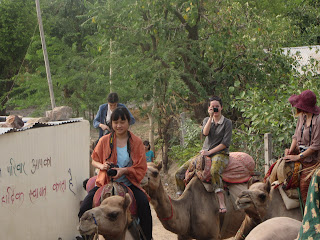After our weekend trip away we returned to Happy Hands with lots of work to do. Akib, Hanif and Sikander were leaving in a week for Ramadan. Hannah, Jo and I worked individually on our experimentation with Akib, offering aid and advice to each other.
There was still no update on our blocks. We decided to start experimenting and not wait on the blocks (just in case).
Hannah, Jo and I all decided to use sheer fabrics, and experimented mainly with the resist paste and black paint.
Hannah had some great ideas, and did of a lot of testing that really raised Akib’s eyebrows.
I still wanted to pursue the layered fabric idea. But after testing the fabrics, Akib and I weren’t able to get the resisted sections white enough.
This is the result after five washes in alizarin to draw the colour out of the resisted sections.
 |
| Black brushed only on the resist print. |
 |
| Black print on sheer grey fabric. |
 |
| Accidental transfer effect. |
 |
| The entire process, step by step. |
 |
| Our experiments |
 |
| Hannah's innovative experiments |
 |
| Waiting for the fabric to dry. Our first completed collaboration with Akib. |
Akib wasn’t quite sure where we were going with the experimentation. We like to think he had fun.
This effect was achieved by accident. Jo had printed on the beforehand, and because her fabric was very sheer, the resist seeped through onto the tablecloth. The residual resist paste transferred very lightly onto my fabric, and it was only visible after brushing the black paint on.
Even though our works were individual, it was evident that there was trend throughout our works. We had all decided to created distorted prints with the resist and black paint and use the less traditional, more geometric blocks. And both Jo and Hannah’s works featured an ombre effect.
I think this was our way of making our block printing contemporary. The three of us struggled initially with block printing looking too traditional for our projects.
We were later showed a fashion show that Akib had collaborated with a designer, a great showcase of how traditional block printing patterns can be used in contemporary fashion.



























































